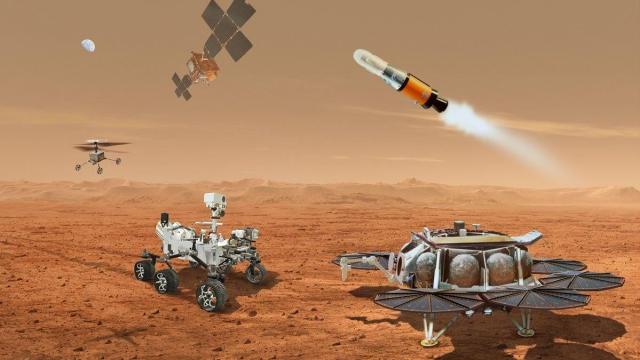NASA is pulling back from its Mars Sample Return program (MSR) in order to develop a revised way of bringing the Martian rocks back to Earth after its original plan was deemed unrealistic.
During a meeting of the Planetary Science Advisory Committee on Monday, NASA officials announced that the space agency is pausing work on MSR in response to a recent report that called out the mission’s mounting costs and delays, Space Policy Online reported. Last week, three NASA centers involved in the MSR program were directed to begin “ramping back” on activities related to the mission, according to Sandra Connelly, deputy associate administrator for science at NASA.
NASA requested $US949.3 million for Mars Sample Return in its budget proposal for 2024. In response, the Senate Appropriations subcommittee responsible for overseeing NASA’s budget allocated $US300 million towards the mission and directed the space agency to submit a year-by-year funding profile for MSR. If NASA is unable to do so, it could face mission cancellation, the subcommittee wrote in its report in July.
NASA’s ambitious plan to return rocky samples from Mars has been under heavy scrutiny for going over its original budget and timeline. In late September, an independent review board (IRB) issued its final report on MSR, referring to it as a “highly constrained and challenging campaign,” with “unrealistic budget and schedule expectations from the beginning.”
In light of the report, NASA announced that it was considering an alternative architecture for its complex mission and formed a response team to address the findings of the report. The report stated that there’s a “a near zero probability” that the lander and orbiter would be ready for launch in 2028, and suggested that the mission’s full lifecycle cost will likely range between $US8 billion and $US11 billion, far more than original estimates.
“We’re pausing the program in fiscal year 2024 while we go off and consider how best to understand and then incorporate how we’re going to change the program and respond to the IRB’s findings,” Jeff Gramling, MSR program director at NASA, is quoted in Space Policy Online as saying during the meeting on Monday. “It’s not just about the architecture, it’s about how do we position the program for long term success and that may mean looking at organizational complexity, internal communications, and how we’re structured to achieve this mission.”
The Sample Return mission involves a group of robots, landers, and orbiters working on and off Mars. NASA’s Perseverance rover is currently collecting rocky samples before stowing them away for a Sample Retrieval Lander to load them up onto a small rocket, from which they will be launched towards another spacecraft in orbit around Mars that is designed to drop them off at Earth in the mid 2030s.
One of the alternative options outlined in the report suggest launching the lander and the orbiter on separate dates, while another suggestion would hand off the responsibility of the orbit entirely to the European Space Agency (NASA’s partner on the mission). During a meeting in late October, Gramling also suggested reducing the quantity of samples returned from Mars, which would result in a smaller container built to house the samples and, therefore, a smaller spacecraft assigned to bring them back to Earth. A smaller spacecraft could reduce cost and complexity for the overall architecture, according to Gramling.
Despite its complex nature, NASA will likely not give up on its Martian sample retrieval mission as it makes up a great portion of the space agency’s plans to send its astronauts to the Red Planet in the 2030s. It also holds significant value in terms of providing important information regarding whether Mars could have hosted some form of life during its ancient past, answering the ultimate question of whether life exists beyond Earth.
It just might take us a little while longer to have those answers as the mission seemingly still has a long way to go before it can drop off the other worldly samples on our planet.
